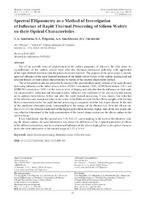Spectral Ellipsometry as a Method of Investigation of Influence of Rapid Thermal Processing of Silicon Wafers on their Optical Characteristics

Date
2022Publisher
Another Title
Спектральная эллипсометрия как метод изучения влияния быстрой термообработки кремниевых пластин на их оптические характеристики
Bibliographic entry
Spectral Ellipsometry as a Method of Investigation of Influence of Rapid Thermal Processing of Silicon Wafers on their Optical Characteristics = Спектральная эллипсометрия как метод изучения влияния быстрой термообработки кремниевых пластин на их оптические характеристики / V. A. Solodukha [et al.] // Приборы и методы измерений. – 2022. – Т. 13, № 3. – С. 199-207.
Abstract
One of the possible ways of improvement of the surface properties of silicon is the solid phase recrystallization of the surface silicon layer after the chemical-mechanical polishing with application of the rapid thermal treatment with the pulses of second duration. The purpose of the given paper is investigation of influence of the rapid thermal treatment of the initial silicon wafers of the various doping level and reticular density on their optical characteristics by means of the spectral ellipsometry method. The investigation results are presented by means of the spectral ellipsometry method of the rapid thermal processing influence on the initial silicon wafers (KDB12 orientation <100>, KDB10 orientation <111> and KDB0.005 orientation <100>) of the various level of doping and reticular density influence on their optical characteristics: refraction and absorption ratios. Influence was confirmed of the silicon reticular density on its optical characteristics before and after the rapid thermal processing. It was shown, that reduction of the refraction and absorption ratios in the center of the Brillouin zone for the silicon samples with the high Boron concentration after the rapid thermal processing as compared with the low doped silicon. In the area of the maximum absorption peak, corresponding to the energy of the electron exit from the silicon surface (4.34 eV) the refraction indicator of the high doped silicon becomes higher, than of the low doped silicon, which is determined by the high concentration of the vacant charge carriers on the silicon surface in this spectral range. It was established, that the spectral area 3.59–4.67 eV, corresponding to the work of the electrons, exiting the silicon surface, the most informative way shows the difference of the 3 optical parameters of silicon of the different orientation, and for evaluation of influence of the silicon doping level on its optical characteristics the most informative is the spectral range of 3.32–4.34 eV.
Abstract in another language
Одним из возможных путей улучшения поверхностных свойств кремния является твердофазная рекристаллизация поверхностного слоя кремния после химико-механической полировки с использованием быстрой термической обработки импульсами секундной длительности. Целью данной работы являлось исследование влияния быстрой термической обработки исходных кремниевых пластин различного уровня легирования и ретикулярной плотности на их оптические характеристики методом спектральной эллипсометрии. Приведены результаты исследования методом спектральной эллипсометрии влияния быстрой термообработки исходных кремниевых пластин (КДБ-12 ориентации <100>, КДБ-10 ориентации <111> и КДБ-0,005 ориентации <100>) различного уровня легирования и ретикулярной плотности на их оптические характеристики: коэффициенты преломления, поглощения. Подтверждено влияние ретикулярной плотности кремния на его оптические характеристики до и после быстрой термообработки. Установлено уменьшение коэффициентов преломления и поглощения в центре зоны Бриллюэна для образцов кремния с высокой концентрацией бора после быстрой термообработки по сравнению с низколегированным кремнием. В области пика максимума поглощения, соответствующего энергии выхода электрона с поверхности кремния (4.34 эВ) показатель преломления высоколегированного кремния становится выше, чем у низколегированного кремния, что обусловлено высокой концентрацией свободных носителей заряда на поверхности кремния в этом спектральном диапазоне. Установлено, что спектральная область 3.59–4.67 эВ, соответствующая работе выхода электронов с поверхности кремния, наиболее информативно показывает различие оптических параметров кремния различной ориентации, а для оценки влияния уровня легирования кремния на его оптические характеристики наиболее информативен спектральный диапазон 3.32–4.34 эВ.
View/
Collections
- Т. 13, № 3[8]
